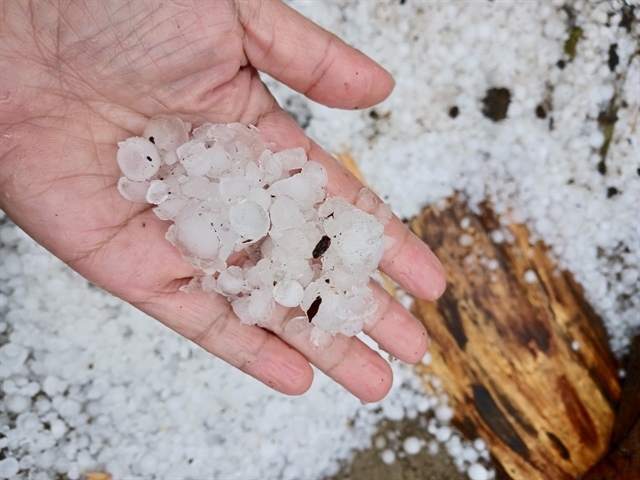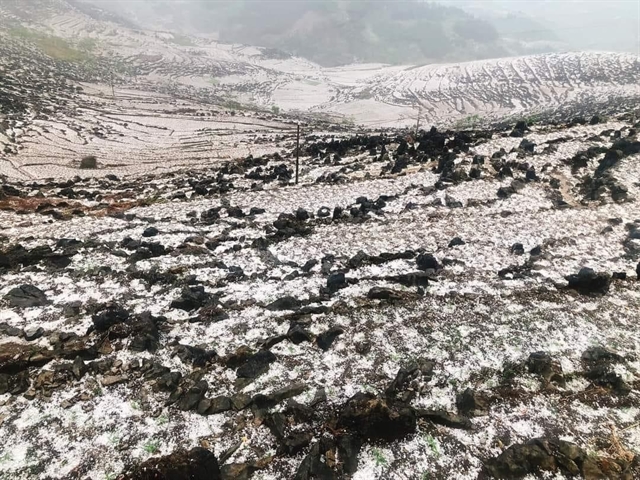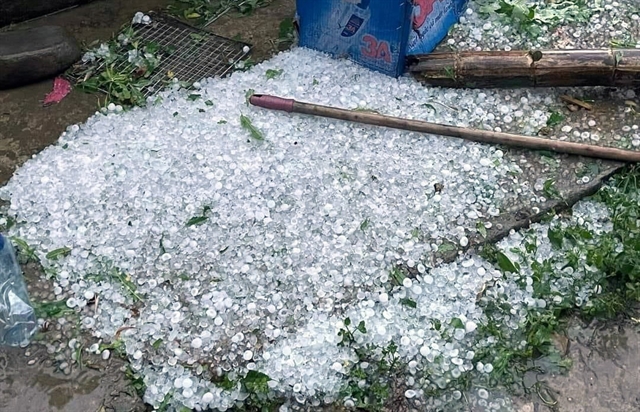 Society
Society


|
| Hailstones with diameter ranging from 1.5 to 2cm in Mù Căng Chải District in the northern mountainous province of Yên Bái. VNA/VNS Photo |
HÀ NỘI — The northern mountainous region has faced persistent hailstorms coupled with thunderstorms over the past two days, leaving one resident injured and causing substantial damage to residential structures and agricultural land.
This weather phenomenon is forecast to become more prevalent, reaching its peak around April and May.
On Thursday, hail and whirlwinds occurred in Yên Bái Province, damaging almost 160 houses and devastating crops across the districts of Mù Cang Chải, Trấn Yên and Văn Chấn.
In Lào Cai Province, the provincial Steering Committee for Natural Disaster Prevention, Search and Rescue reported that on Friday morning, hailstorms and whirlwinds injured one person in Bát Xát Town. Currently, the individual is receiving treatment at the Bát Xát District General Hospital.
Initial statistics showed that 48 houses were destroyed in Bát Xát, Mường Khương, Si Ma Cai and Bắc Hà districts. Bát Xát District was the hardest hit with 37 affected houses, including nine houses being destroyed in Bát Xát Town. Approximately 60m of fencing at the Vocational Training and Education Centre collapsed and the roof of a canteen was blown off.
Numerous trees fell on various roads in Mường Hum and Phìn Ngan communes and Bát Xát Town, affecting transportation and the power grid. The total damage was estimated to be around VNĐ100 million.

|
| A blanket of white hail covering Mèo Vạc District in the northern mountainous province of Hà Giang. VNA/VNS Photo |
In Sơn La Province’s Chiềng Khay Commune, serious damage was reported to 11 houses and others sustained damage to auxiliary structures such as kitchens or livestock shelters after hail fell on Friday morning. About ten hectares were damaged.
Prior to this, two hailstorms hit Mộc Châu Town and some nearby communes with the hailstones measuring 1-2 cm in diameter. Hailstorms accompanied by whirlwinds affected many areas of plum and strawberry and other crops.
Tuyên Quang Province’s natural disaster committee also reported initial losses: 409 houses were damaged across the province along with community houses, schools and factories. Hail and tornadoes damaged more than 180 ha of crops and forest.
Cao Bằng Province reported that thunderstorms and heavy rains caused VNĐ200 million in crop and property damage. A total of 160 houses had their roofs collapse and four schools and a medical centre were damaged.

|
| Heavy rain was accompanied by hail in Sơn La Province's Chiềng Khay Commune. VNA/VNS Photo |
Local authorities promptly conducted damage assessments, mobilised on-site forces to address the damage, and provided temporary shelter and food for affected families.
Explaining this phenomenon, Nguyễn Văn Hưởng, head of the Weather Forecast Department at the National Meteorological and Hydrological Forecast Centre, stated on Friday that the northern mountainous region is currently undergoing a seasonal transition from spring to summer. During this period, the region will experience more frequent thunderstorms, hailstorms and tornadoes, concentrated from March to May, with the peak in April.
The direct cause of this phenomenon is a weak cold system from the north descending onto relatively warm temperatures in the northern region, creating conditions for strong air disturbances and convective clouds. This leads to thunderstorms accompanied by lightning, hail and whirlwinds.
Hưởng also suggested that people should regularly monitor weather forecasts and warnings on the website of the National Meteorological and Hydrological Forecast Centre, as well as local meteorological stations, and stay updated on the latest weather forecasts.
Local authorities and relevant agencies should promptly provide disaster forecasts to the public. Moreover, strict adherence to the guidelines for disaster response and prevention issued by local authorities is essential, he said. — VNS




